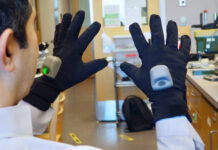Nanomaterials are so tiny that they’re up to a billion times smaller than a person, and at that scale they can have properties that they wouldn’t otherwise have, and that no one predicted. That’s why they’re so interesting to study, especially for scientists who like to push the boundaries of imagination.
And with electronics being as the foundation of many of our modern devices, the remarkable excitation and transport of electrons in nanomaterials is of particular interest to Alireza Nojeh, professor of electrical and computer engineering at the University of British Columbia’s Stewart Blusson Quantum Matter Institute.
Nojeh uses light as a tool to bring out quantum features, and he never knows what his team might find.
“The area that we are currently focussing on is something that we stumbled upon accidentally during some experiments, and that’s an effect that we call a heat trap,” says Nojeh.
“What it consists of is illuminating a collection of carbon nanotubes with a focussed beam of light; the material absorbs the light and gets heated. Although this is a conductive material — you would expect the heat to go everywhere — it actually gets very strongly confined where you generate the heat, hence the name heat trap.”
Shining a very small amount of light onto these arrays of carbon nanotubes can generate incredible temperatures of upwards of 1500 °C. In turn, that kind of heat can enable unusual properties of its own.
“Once you heat the material to that degree, all sorts of interesting things happen,” adds Nojeh. “It makes it a lot easier to create a focussed beam of electrons for applications that range from energy conversion to harvest sunlight or harvest waste heat and generate electricity, all the way to a simple and compact electron microscope.”
The entire concept of making a heat trap out of a conductive material defied all expectations, and yet it was discovered using an imaginative approach to break out of the box.
“Thinking about imagination and playfulness in science, I like to think of it as guided imagination,” says Nojeh. “One normally does start with a hypothesis or a direction of thought, but it’s very important to keep an open mind.
“Normally in the scientific process, you’re not looking to prove a hypothesis, you’re trying to refute it, so you try to throw at it whatever you can, and in the process see what else captures your attention. And the heat trap effect that I mentioned was precisely like this. Like I said, we had no reason to put that green laser on this material, and we thought, let’s do it and see what happens.”






































